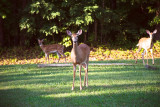
No matter how carefully state-agency wildlife biologists use computerized models to convert elk and deer data into population estimates, one outcome remains certain: Many hunters dismiss the numbers as high, and question the agency’s motives if it boosts antlerless tags to reduce the herd.
That’s nothing new. Hunters and biologists long ago made “deer wars”part of North America’s hunting culture. During the early 1940s, Wisconsin hunters routinely defamed Aldo Leopold – the father of scientific wildlife management – for recommending the state imposed antlerless-only hunts to reduce over browsing in the state’s Northern forests. Leopold scorned the hunters’ winter feeding programs, saying they artificially inflated the herd beyond the habitat’s carrying capacity, which wasn’t sustainable for neither deer nor forest.
Educating the public about such challenges is never easy. In the late 1950s, The Milwaukee Journal’s Mel Ellis had had his work sabotaged after covering a North Woods deer-management meeting. After writing and filing his account later that night from a nearby telegraph depot, Ellis went to bed. But when he read his column in the Journal the next day, its conclusions were opposite of what he filed. Ellis confronted the telegrapher, yelling, “You know you could get fired for doing a thing like that?!”
“I don’t give a damn, Ellis. I wouldn’t send a story like that for no man,” the man replied.
Spats today go beyond excessive herbivory and deer-altered habitats. They also pit hunters’ recreational desires against other people’s property losses caused by elk or deer. Those losses include antler-rub damage to trees and saplings; browse damage to trees, shrubs and agricultural crops; and collision damage to cars, trucks and motorcycles, which sometimes include injury and death.
Different Perspectives
Wildlife agencies and their biologists seem forever caught between hunters who want to see more deer, and deer-pained people who seek relief. Those desires cause different perceptions about deer herds. The Iowa Department of Natural Resources, for instance, studied how hunters and farmers viewed spiking deer numbers 20 years ago. Surveys in 1996 and 2002 asked, “The current deer population is …?”
Hunters’ perceptions barely changed during the six-year period. However, the percentage of hunters who thought numbers were too low actually increased, while those thinking numbers were too high decreased. Here’s how hunters perceived Iowa’s deer herd:
- About right: 60 percent in 1996; 63 percent in 2002.
- Too high: 26 percent in 1996, 21 percent in 2002.
- Too low: 14 percent in 1996, 16 percent in 2002.
Farmers’ perceptions, meanwhile, changed by double digits:
- Too high: 52 percent in 1996, 67 percent in 2002.
- About right: 42 percent in 1996, 30 percent in 2002.
- Too low: 6 percent in 1996, 3 percent in 2002.
After assessing the situation, the Iowa DNR boosted antlerless quotas and sold substantially more resident gun-deer licenses in the new century. Tag sales peaked in 2009 at levels 35 percent higher than in 2002. By 2017, sales were 17 percent higher than 2002’s level.
Hunters, of course, are asked their perceptions and preferences about elk and deer numbers more often than are non hunters. The Michigan DNR, for example, has surveyed up to 414 deer camps in the state’s Upper Peninsula annually since 1994 to gauge their satisfaction with the state’s 16-day firearms deer season, and their impressions of the herd.
Not once from 1994 through 2016 did a majority of camps say deer were more numerous than the previous season. (In 2010, equal percentages, 36 percent, judged deer numbers “more” and “same.”)That stubborn belief held even when the camps’ average number of deer sightings increased from the previous year, which happened 14 of those 23 years (61 percent). That streak ended in 2016 and 2017 as the herd rebounded after being decimated by brutal winters in 2013-2014 and 2014-2015.
Questions of Motive
Skepticism of elk and deer estimates also fosters conspiracy theories when wildlife agencies ask hunters to reduce herds. Perhaps the most rampant rumor is that the insurance industry coerces reductions by pressuring politicians and wildlife agencies.
I recently asked three state wildlife directors, and a former DNR chief and state senator, if they’ve ever been lobbied by insurance companies about deer numbers. None of the former or current directors – Jon Gassett, Kentucky; Mike Tonkovich, Ohio; and Matt Knox, Virginia – had ever discussed wildlife issues with an insurance-industry representative. Likewise, Cathy Stepp, a former Wisconsin DNR secretary and state senator, said she never discussed deer-vehicle accidents with anyone from the insurance industry.
All four said they hear only from drivers who hit deer, not the companies insuring them. In fact, they found the accusations silly, given the sophisticated calculations insurance companies use to ensure profitability. Car-deer accidents generate endless data that actuaries use to assess and predict their clients’ risks. Their analyses break down each accident by week, month, weekday, state, county, township, driver’s age, driver’s sex, injury rates, repair costs, time of day, and the vehicle’s make, model and year.
Bottom line: If you live where car-deer accidents are common, you’ll pay higher car-insurance premiums for the same vehicle than drivers living where such accidents are rare.
Are Estimates Worthwhile?
Conspiracy theories and skepticism of herd estimates do affect how agencies operate. That is, agency biologists and administrators often don’t discuss herd estimates. Knox, Virginia’s longtime deer-project coordinator considers herd estimates unnecessary.
“I don’t know how many deer are in my home county,” Knox said. “I can estimate our statewide herd with a population-reconstruction model, but that’s for my own curiosity. Don’t ask me to defend it publicly and swear to it. Whatever number I say, that’s all we’ll fight about. If I say there’s X number of deer and your car hits a deer, you say it’s 2X. But if you hunt that area, you’ll say it’s X over 2 (x/2). I’ll never convince anyone I’m right, so why put an estimate out there? It’s just a red flag that gets everyone fighting.”
Valerius Geist, professor emeritus of environmental sciences at the University of Calgary in Alberta, Canada, said population estimates have some value as an index or trend indicator. He said, however, that wildlife management seldom requires precision.
“Our biologists suffer greatly from physics envy,” Geist said. “We all want to be super-scientists and physicists, but we don’t have to account for every wolf or deer on the landscape. Wildlife biologists sometimes take quantification to the edge of absurdity.”
Dr. Gary Alt spent 25 years running the Pennsylvania Game Commission’s black-bear program before directing its white-tailed deer program from 1999 through 2004. Alt said hunters often obsess about deer numbers, but he tells them: “I don’t know the exact number and no one else knows, either.”
Alt thinks herd estimate salso miss the point. What’s more relevant?
“You look at their impacts on crops, woodlots and forests, and decide whether the population needs to go up or down,” Alt said. “Farmers don’t do multi-million dollar studies to know when to move their cows. They send their kids out to inspect the pasture. When the grass gets grazed too low, they move the cows and let the pasture recover.”
Alt said population estimates are more important and require more precision when managing wolves, grizzlies or other animals on state or federal threatened/endangered species lists. Track counts, aerial surveys and population modeling help estimate minimum numbers, which can help determine if a species is sustainable, threatened or endangered.
In contrast, deer and elk often cause problems of abundance. Tonkovich, who serves as Ohio’s deer program administrator, notes that the Ohio DNR spent the past year conducting a “stakeholder engagement exercise” with the public. That effort reminded folks not to judge each other’s population perceptions.
“That (exercise) and my 25 years of experience convinced me that hunter satisfaction has little to do with deer numbers, in spite of what hunters say or believe,” Tonkovich said. “(Hunter satisfaction) has everything to do with how frequently we engage our hunters in meaningful conversations about our deer-management decisions. They might not agree with our decisions, but we need their acceptance.”







Conversation